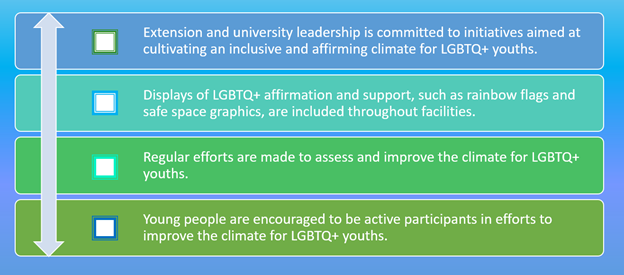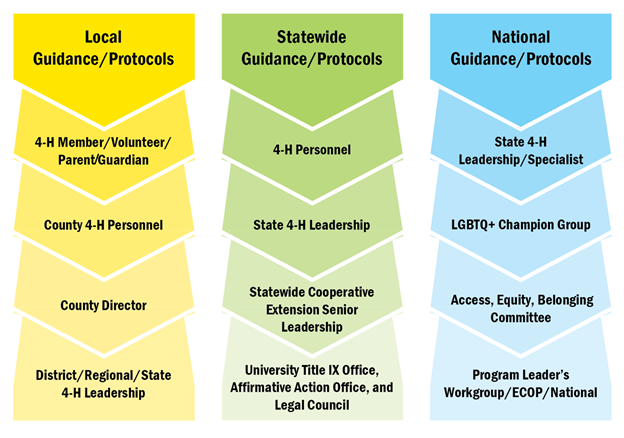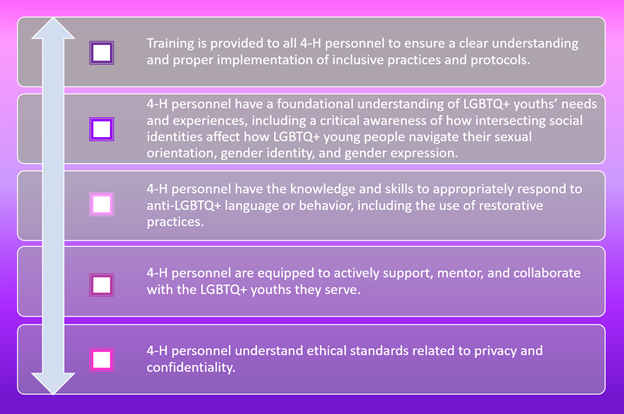 |
August 2020
|
August 2020 // Volume 58 // Number 4 // Tools of the Trade // v58-4tt4
"Making the Best Better" for Youths: Cultivating LGBTQ+ Inclusion in 4-H
Abstract
4-H, as a research-based positive youth development program, should be affirming and inclusive for all youths, including those who are members of LGBTQ+ communities. This article provides 4-H youth development professionals with a series of checklists for supporting LGBTQ+ participation, focusing on systemic advocacy, guidance and protocols, programming, and professional development and dispositions. Using these checklists, 4-H professionals can identify areas of strength and growth for themselves and their programs. Further, they can enable youth thriving, increase protective factors, and reduce risk factors by cultivating inclusive and affirming 4-H spaces.
Despite recent legislative and sociopolitical advancements for lesbian, gay, bisexual, transgender, and queer (LGBTQ+) communities, LGBTQ+ youths continue to experience hostility and isolation at school and in their communities (Gonzalez, 2017; Kosciw, Greytak, Zongrone, Clark, & Truong, 2018). Family rejection is another obstacle for many LGBTQ+ young people (Bregman, Malik, Page, Makynen, & Lindahl, 2013), resulting in substantially higher rates of homelessness when compared to their heterosexual, cisgender counterparts (Morton, Dworsky, Samuels, & Patel, 2018). The cumulative impact of such experiences puts LGBTQ+ youths at significantly higher risk for experiencing drug and alcohol abuse, depression, anxiety, and suicide (Fish & Pasley, 2015; Russell & Fish, 2016).
Although these statistics are disheartening, research in the field of positive youth development (PYD) demonstrates, unequivocally, that youths thrive when they (a) are supported by and connected to their environments, (b) possess a positive sense of self, and (c) feel empowered to engage in positive social change (Lerner et al., 2005; Search Institute, 2018). LGBTQ+ youths in particular benefit socially, emotionally, and academically when they can identify at least one supportive adult, when they attend schools and community organizations with comprehensive antibullying policies, and when they have access to inclusive programmatic curricula (Kosciw et al., 2018). Indeed, supportive and connected environments—such as those offered by organizations like 4-H—foster resilience and nurture engagement (Nathaniel & Kinsey, 2013; Warren & Kupscznk, 2016).
According to its motto, 4-H personnel, including volunteers, are called on "to make the best better" for all youths. To do so, they are trained to promote youths' strengths and socioemotional development within equitable and trusting environments through a positive youth development framework (Damon, 2004; Duke, 2014). Nevertheless, 4-H programs and practices should be more intentional and proactive in supporting LGBTQ+ youths (Soule, 2017). The purpose of this article, therefore, is to assist 4-H professionals in identifying and developing the knowledge, skills, and dispositions necessary to comprehend and properly address the needs of the LGBTQ+ youths they serve within 4-H and beyond.
Best Practices for Supporting LGBTQ+ Youths in 4-H
Drawing on relevant literature (Kosciw et al., 2018; Wagaman, 2016), we created a series of checklists for cultivating LGBTQ+ inclusion in 4-H with an emphasis on four overarching areas: systemic advocacy, guidance and protocols, programming, and professional development and dispositions. Our four areas, defined herein, are organized into four respective checklists, illustrated as figures and intended for use as a reflective tool to assist 4-H professionals in identifying emerging best practices that foster a welcoming environment for LGBTQ+ individuals. The arrows to the left of each checklist indicate that the process of cultivating LGBTQ+ inclusivity is fluid and iterative, rather than linear.
Systemic Advocacy
Systemic advocacy, as outlined in Figure 1, refers specifically to 4-H administrators at the national, state, and county levels who demonstrate an unyielding commitment to equity and inclusion for LGBTQ+ youths, which is foundational to the successful implementation of these best practices. Examples of systemic advocacy include actively supporting efforts—such as professional development for staff—aimed at fostering inclusivity for LGBTQ+ youths; displaying LGBTQ+ affirming posters and messages, including rainbow flags, throughout 4-H facilities; regularly evaluating and seeking to improve the climate for LGBTQ+ young people through needs assessments and climate surveys; and involving LGBTQ+ youths in systemic change efforts, including participation on advisory boards.
Figure 1.
Systemic Advocacy

Guidance and Protocols
Guidance and protocols refer to adopted guidelines and standards of practice aimed at ensuring equity and inclusion for all people employed or served by Extension, including those who are LGBTQ+. Although protection of employees is often addressed by human resources policies, inclusion practices for youths and volunteers fall to each land-grant universities' Extension administration to create and institutionalize. An essential first step in successfully implementing LGBTQ+ inclusive practices is supporting the development of guidelines on how to effectively implement the university's nondiscrimination statement in the state's 4-H program. This includes defining a process for appropriate use of pronouns, restroom facilities, showers for overnight programs, and lodging arrangements (Figure 2).
Figure 2.
Guidance and Protocols

Figure 3 demonstrates a suggested line of communication to support those seeking clarity regarding guidance and protocols. A person's role in the program influences the best initial contact for support. The top level in the figure identifies an individual who is seeking clarity, with the cascading lower levels indicating a progression of program contacts.
Figure 3.
Suggested Points of Contact for Guidance and Protocol Advice/Clarity

Note. ECOP = Extension Committee on Organization and Policy
Programming
Structural and instructional changes to programming can improve environments for LGBTQ+ youths, as described in Figure 4. Structural changes include the use of program materials that feature gender-neutral terms (e.g., "youths" instead of "boys and girls") and represent a diversity of people, cultures, and communities, including a variety of genders and family structures (Soule, 2017). Programming also refers to the ways in which information relating to participants' genders, names, pronouns, parents/caregivers, and accommodation needs is collected (e.g., using "fill in the blank" answer spaces for gender and pronouns; avoidance of "other" as an option; using "parents/caregivers" instead of "mom and dad"). Instructional changes include facilitating with gender-neutral language, avoiding categorizing youths or activities by gender, and sharing pronouns in group introductions and icebreaker activities. In addition, any events related to families reflect all family structures, and any dances and 4-H celebrations affirm all youths, including those who are LGBTQ+. Beyond adopting affirming practices, establishing inclusive programming encourages participants to develop a critical understanding of social identities, power, oppression, and privilege and openly supports opportunities for young people to commemorate LGBTQ+ related events, such as Pride Month.
Figure 4.
Programming

Professional Development and Dispositions
Systemic advocacy, affirming protocols, and inclusive programming are essential in cultivating a supportive environment for LGBTQ+ youths. However, effective enforcement necessitates personnel, including volunteers, who have undergone comprehensive professional development and possess the competence and dispositions to work with LGBTQ+ young people (Gonzalez, 2017). Such competence, as illustrated in Figure 5, includes an understanding that LGBTQ+ youths who are members of other socially marginalized groups (e.g., people of color, working class, people with disabilities) face unique challenges that often magnify the effects of heterosexism and transgender oppression (Toomey, McGuire, & Russell, 2012). Further, professional development and dispositions include appropriately responding to incidents of anti-LGBTQ+ bias and actively supporting, mentoring, and advocating for and with LGBTQ+ youths.
Figure 5.
Professional Development and Dispositions

Conclusion
These checklists serve as an entry point for dialogue and reflection on how 4-H programs can best support LGBTQ+ youths. They also provide a road map for identifying and implementing emerging best practices aimed at cultivating more welcoming environments for LGBTQ+ people across Extension. Moving forward, additional research—both empirical and conceptual—is needed to examine the experiences of LGBTQ+ youths within 4-H and to investigate the knowledge, skills, and dispositions of 4-H professionals as they relate to working with LGBTQ+ young people. Such scholarship coupled with the implementation of these best practices will substantially aid in realizing 4-H's commitment to "making the best better" for all youths.
References
Bregman, H. R., Malik, N. M., Page, M. J., Makynen, E., & Lindahl, K. M. (2013). Identity profiles in lesbian, gay, and bisexual youth: The role of family influences. Journal of Youth & Adolescence, 42(3), 417–430.
Damon, W. (2004). What is positive youth development? The Annals of the American Academy of Political and Social Science, 591, 13–24. doi:10.1177/0002716203260092
Duke, A. (2014). Creating safe spaces within Extension programs. Journal of Extension, 52(6), Article v52-6tt2. Available at: https://www.joe.org/joe/2014december/tt5.php
Fish, J. N., & Pasley, K. (2015). Sexual (minority) trajectories, mental health, and alcohol use: A longitudinal study of youth as they transition to adulthood. Journal of Youth and Adolescence, 44, 1508–1527. doi:10.1007/s10964-015-0280-6.
Gonzalez, M. (2017). Advocacy for and with LGBT students: An examination of high school counselor experiences. Professional School Counseling, 20(1a), 38–46. doi:10.5330/1096-2409-20.1a.38
Kosciw, J. G., Greytak, E. A., Zongrone, A. D., Clark, C. M., & Truong, N. L. (2018). The 2017 National School Climate Survey: The experiences of lesbian, gay, bisexual, transgender, and queer youth in our nation's schools. New York, NY: GLSEN.
Lerner, R. M., Lerner, J. V., Almerigi, J., Theokas, C., Phelps, E., Gestsdóttir, S., . . . von Eye, A. (2005). Positive youth development, participation in community youth development programs, and community contributions of fifth-grade adolescents: Findings from the first wave of the 4-H Study of Positive Youth Development. Journal of Early Adolescence, 25(1), 17–71.
Morton, M. H., Dworsky, A., Samuels, G. M., & Patel, S. (2018). Missed opportunities: Youth homelessness in rural America. Chicago, IL: Chapin Hall at the University of Chicago.
Nathaniel, K. C., & Kinsey, S. B. (2013). Contributions of youth engagement to the development of social capital through community mapping. Journal of Extension, 51(1), Article v51-1tt7. Available at: https://joe.org/joe/2013february/tt7.php
Russell, S. T., & Fish, J. N. (2016). Mental health in LGBT youth. Annual Review of Clinical Psychology, 12, 465–487. doi:10.1146/annurev-clinpsy-021815-093153 PMCID: PMC4887282
Search Institute. (2018). Developmental assets among U.S. youth: 2018 update. Minneapolis, MN: Search Institute.
Soule, K. E. (2017). Creating inclusive youth programs for LGBTQ+ communities. Journal of Human Sciences and Extension, 5(2), 103–125.
Terry, D. (2015, June 9). In the crosshairs. Retrieved from https://medium.com/hatewatch-blog/in-the-crosshairs-3700fbf2203d
Toomey, R. B., McGuire, J. K., & Russell, S. T. (2012). Heteronormativity, school climates, and perceived safety for gender nonconforming peers. Journal of Adolescence, 35, 187–196. http://dx.doi.org/10.1016/j.adolescence.2011.03.001
Wagaman, M. A. (2016). Promoting empowerment among LGBTQ youth: A social justice youth development approach. Child and Adolescent Social Work Journal, 33, 395–405. https://doi.org/10.1007/s10560-016-0435-7
Warren, M. R., & Kupscznk, L. A. (2016). The emergence of a youth justice movement in the United States. In J. Conner & S. Rosen (Eds.), Contemporary youth activism: Advancing social justice in the United States (pp. 39–58). Santa Barbara, CA: Prager.




